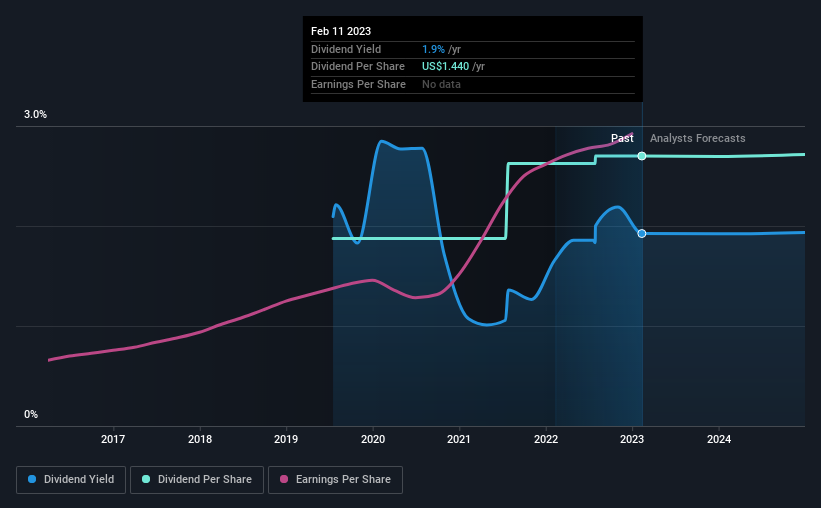Is It Smart To Buy Western Alliance Bancorporation (NYSE:WAL) Before It Goes Ex-Dividend?
Regular readers will know that we love our dividends at Simply Wall St, which is why it's exciting to see Western Alliance Bancorporation (NYSE:WAL) is about to trade ex-dividend in the next 4 days. The ex-dividend date is usually set to be one business day before the record date which is the cut-off date on which you must be present on the company's books as a shareholder in order to receive the dividend. It is important to be aware of the ex-dividend date because any trade on the stock needs to have been settled on or before the record date. Accordingly, Western Alliance Bancorporation investors that purchase the stock on or after the 16th of February will not receive the dividend, which will be paid on the 3rd of March.
The company's next dividend payment will be US$0.36 per share, and in the last 12 months, the company paid a total of US$1.44 per share. Last year's total dividend payments show that Western Alliance Bancorporation has a trailing yield of 1.9% on the current share price of $74.82. If you buy this business for its dividend, you should have an idea of whether Western Alliance Bancorporation's dividend is reliable and sustainable. That's why we should always check whether the dividend payments appear sustainable, and if the company is growing.
See our latest analysis for Western Alliance Bancorporation
Dividends are usually paid out of company profits, so if a company pays out more than it earned then its dividend is usually at greater risk of being cut. Western Alliance Bancorporation has a low and conservative payout ratio of just 15% of its income after tax.
Generally speaking, the lower a company's payout ratios, the more resilient its dividend usually is.
Click here to see the company's payout ratio, plus analyst estimates of its future dividends.
Have Earnings And Dividends Been Growing?
Businesses with strong growth prospects usually make the best dividend payers, because it's easier to grow dividends when earnings per share are improving. If earnings fall far enough, the company could be forced to cut its dividend. That's why it's comforting to see Western Alliance Bancorporation's earnings have been skyrocketing, up 25% per annum for the past five years.
The main way most investors will assess a company's dividend prospects is by checking the historical rate of dividend growth. Western Alliance Bancorporation has delivered an average of 13% per year annual increase in its dividend, based on the past three years of dividend payments. It's exciting to see that both earnings and dividends per share have grown rapidly over the past few years.
To Sum It Up
Should investors buy Western Alliance Bancorporation for the upcoming dividend? Typically, companies that are growing rapidly and paying out a low fraction of earnings are keeping the profits for reinvestment in the business. This is one of the most attractive investment combinations under this analysis, as it can create substantial value for investors over the long run. Overall, Western Alliance Bancorporation looks like a promising dividend stock in this analysis, and we think it would be worth investigating further.
On that note, you'll want to research what risks Western Alliance Bancorporation is facing. To help with this, we've discovered 3 warning signs for Western Alliance Bancorporation that you should be aware of before investing in their shares.
A common investing mistake is buying the first interesting stock you see. Here you can find a full list of high-yield dividend stocks.
Have feedback on this article? Concerned about the content? Get in touch with us directly. Alternatively, email editorial-team (at) simplywallst.com.
This article by Simply Wall St is general in nature. We provide commentary based on historical data and analyst forecasts only using an unbiased methodology and our articles are not intended to be financial advice. It does not constitute a recommendation to buy or sell any stock, and does not take account of your objectives, or your financial situation. We aim to bring you long-term focused analysis driven by fundamental data. Note that our analysis may not factor in the latest price-sensitive company announcements or qualitative material. Simply Wall St has no position in any stocks mentioned.
Join A Paid User Research Session
You’ll receive a US$30 Amazon Gift card for 1 hour of your time while helping us build better investing tools for the individual investors like yourself. Sign up here

 Yahoo Finance
Yahoo Finance 
